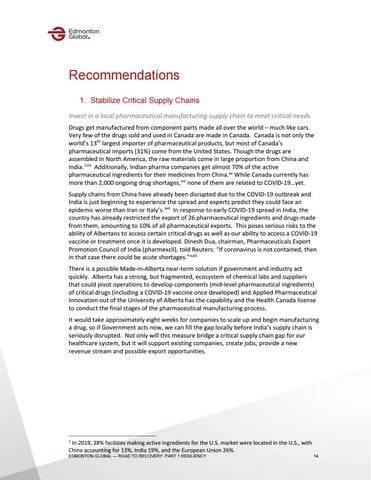Recommendations 1. Stabilize Critical Supply Chains Invest in a local pharmaceutical manufacturing supply chain to meet critical needs Drugs get manufactured from component parts made all over the world – much like cars. Very few of the drugs sold and used in Canada are made in Canada. Canada is not only the world’s 13th largest importer of pharmaceutical products, but most of Canada’s pharmaceutical imports (31%) come from the United States. Though the drugs are assembled in North America, the raw materials come in large proportion from China and India. 1xiv Additionally, Indian pharma companies get almost 70% of the active pharmaceutical ingredients for their medicines from China. xv While Canada currently has more than 2,000 ongoing drug shortages, xvi none of them are related to COVID-19…yet. Supply chains from China have already been disrupted due to the COVID-19 outbreak and India is just beginning to experience the spread and experts predict they could face an epidemic worse than Iran or Italy’s. xvii In response to early COVID-19 spread in India, the country has already restricted the export of 26 pharmaceutical ingredients and drugs made from them, amounting to 10% of all pharmaceutical exports. This poses serious risks to the ability of Albertans to access certain critical drugs as well as our ability to access a COVID-19 vaccine or treatment once it is developed. Dinesh Dua, chairman, Pharmaceuticals Export Promotion Council of India (pharmexcil), told Reuters: “If coronavirus is not contained, then in that case there could be acute shortages.” xviii There is a possible Made-in-Alberta near-term solution if government and industry act quickly. Alberta has a strong, but fragmented, ecosystem of chemical labs and suppliers that could pivot operations to develop components (mid-level pharmaceutical ingredients) of critical drugs (including a COVID-19 vaccine once developed) and Applied Pharmaceutical Innovation out of the University of Alberta has the capability and the Health Canada license to conduct the final stages of the pharmaceutical manufacturing process. It would take approximately eight weeks for companies to scale up and begin manufacturing a drug, so if Government acts now, we can fill the gap locally before India’s supply chain is seriously disrupted. Not only will this measure bridge a critical supply chain gap for our healthcare system, but it will support existing companies, create jobs, provide a new revenue stream and possible export opportunities.
In 2019, 28% facilities making active ingredients for the U.S. market were located in the U.S., with China accounting for 13%, India 19%, and the European Union 26%.
1
EDMONTON GLOBAL — ROAD TO RECOVERY: PART 1 RESILIENCY
14

